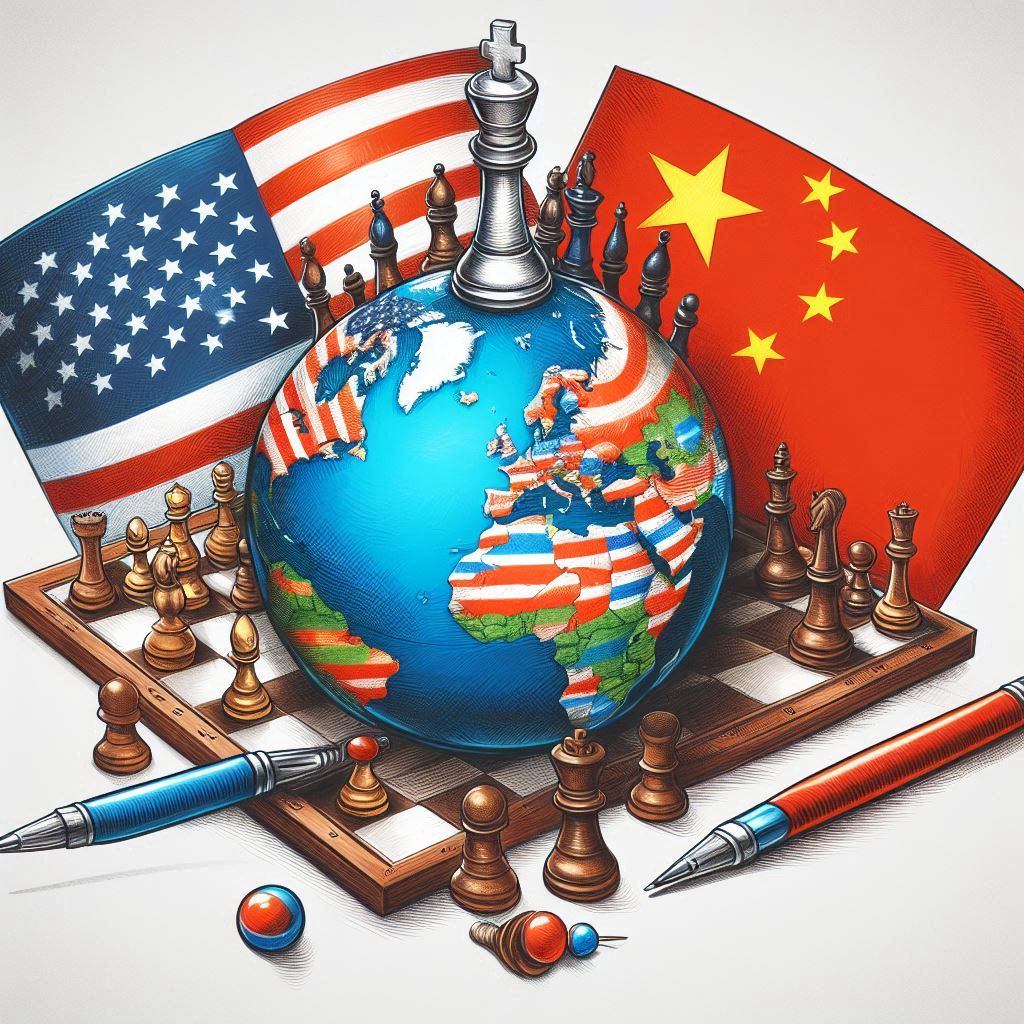
Category: East Asia

Migration throws Laos’ communist government a lifeline
In a rare moment in the international spotlight, Laos was the topic of two articles published by major world media outlets in early October, although not with the sort of headlines the ruling communist party wanted to read. The BBC ran a piece on October 8 under the banner: “’I feel hopeless’: Living in Laos on the brink”. Days later, the Washington Post went with “China’s promise of prosperity brought Laos debt — and distress”, presumably because the editors thought Laos isn’t interesting enough unless tales of Chinese debt traps are also included. But both gave an accurate sense of the grim situation most Laotians, especially the young, now find themselves in. As the BBC report began: “Confronted with a barren job market, the Vientiane resident holds no hope of finding work at home, and instead aims to become a cleaner or a fruit picker in Australia.” Laotians are leaving the country in droves. My estimate is that around 90,000, perhaps more, will have migrated officially by the end of the year, joining around 51,000 who left last year and the hundreds of thousands who have moved abroad earlier. Laos has had a horrendous last few years. The landlocked Southeast Asian nation didn’t do particularly well during the COVID-19 pandemic. Since the early months of 2021, it has had one of the worst inflation rates in Asia, peaking at 41.3 percent in February and still hovering at around 25 percent. The kip, the local currency, is collapsing; it hit an all-time low in mid-September when it was trading in commercial banks at 20,000 to the U.S. dollar, compared to around 8000 (US$44) in 2019. An acquaintance in Vientiane tells me that it used to cost 350,000 kip to fill up his car with diesel in 2019; today, it’s closer to 1.2 million kip (US$58) and the price keeps rising—and bear in mind that the minimum wage is now just 1.6 million kip (US$77), per a tiny increase in October. Another correspondent of mine, a foreigner, says he’s now leaving: “It’s got to the point where I’m just… done!” Motorcyclists line up for gas in Laos amid shortages, May 10, 2022. Credit: RFA The communist government is hopeless in responding, and not even the rare resignation of a prime minister last December has added any vitality to its efforts. Worse, far larger structural problems remain. The national debt, probably around 120 percent of GDP, puts Laos at risk of defaulting every quarter. It cannot continue to borrow so the authorities are jacking up taxation, and because of flagrant corruption, the burden falls more heavily than it should on the poor. Looking ahead, what is the national debt if not a tax deferred on the young and yet-to-be-born? There are not enough teachers in schools and not enough schools for students. Attendance rates have plummeted. Public expenditure on education and health, combined, has fallen from 4.2 percent of GDP in 2017 to just 2.6 percent last year, according to the World Bank’s latest economic update. More than two-thirds of low-income families say they have slashed spending on education and healthcare since the pandemic began, it also found. According to the BBC report, 38.7 percent of 18-to-24-year-olds are not in education, employment or training, by far the highest rate in Southeast Asia. A Laotian youth told me that few people want to waste money on bribes to study at university when they can quickly study Korean and try to get a high-paying factory job in Seoul. In June, an International Labour Organization update gave a summary of the numbers of Laotians leaving by official means, as estimated by the Ministry of Labour and Social Welfare: Thailand 2022: 51,501 (29,319 women) 2023, up until 30 June: 42,246 (23,126 women) Malaysia 2022: 469 men Japan 2022: 312 (122 women) 2023, up until 30 June: 289 (120 women) South Korea, long-term (3 years contract) 2022: 796 (194 women) 2023, up until 30 June: 389 (54 women) South Korea, short-term seasonal workers (5 months contract) 2022: 1,356 (598 women) The first thing to note is that this is emigration by official channels. To Japan and South Korea, that official process is arduous and involves a lengthy contract procedure before leaving the country. However, the workers in South Korea can earn in a day what they would earn in a month in Laos. It’s less strenuous getting to Thailand although a considerable number of Laotians emigrate there by unofficial means, hopping across the border and not registering that they’ve left. In 2019, the Thai authorities estimated that there were around 207,000 Lao migrants working legally and 30,000 illegally, but the actual number of legal and illegal workers could have been as high as 300,000. (No one really knows how many Laotians work illegally in Thailand.) Also, consider how many Laotians have left the country so far this year compared to 2022. If we assume that emigration flows keep the same pace in the last six months of 2023 as they did in the first six, around 84,000 Laotians will have officially emigrated to Thailand by the end of this year, up from 51,000 in 2022. In April, a National Assembly delegate castigated the government for the fact that “workers have left factories in Laos for jobs in other countries because the wages paid by factories here are not keeping pace with the rising cost of living…As a result, factories in Laos are facing a labor shortage.” Saving grace? But isn’t this actually a saving grace for the communist Lao People’s Revolutionary Party (LPRP), at least in the short term? Much woe betide is made of Laos’ land-locked geography but it is rather convenient to border five countries, four of which are wealthier, if you want to avoid a situation of having disaffected, unemployed or poorly paid youths hanging around doing nothing but getting increasingly angry at their dim prospects. Conventional wisdom holds that authoritarian regimes constrain emigration as it can lead to mass labor shortages, one reason…
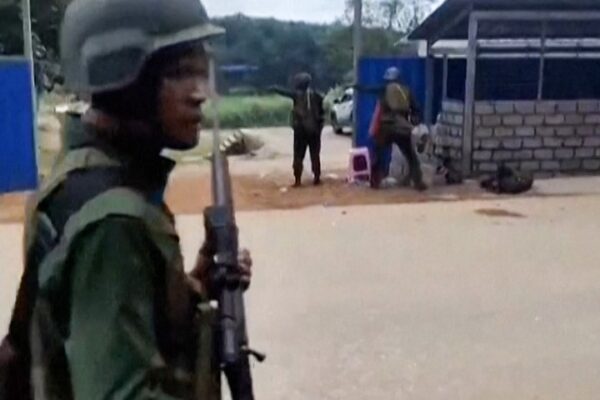
Ethnic alliance launches offensive on junta in eastern Myanmar
An alliance of three ethnic armies opened an offensive against Myanmar’s military regime on Friday, launching attacks on outposts in seven different locations in Shan state, in the east, including the headquarters of the junta’s Northeastern Command. At around 4:00 a.m., the Northern Alliance made up of the Ta’ang National Liberation Army, Myanmar National Democratic Alliance Army and the Arakan Army simultaneously struck junta positions in the strategic Shan cities of Kunlong, Theinni, Chin Shwe Haw, Laukkaing, Namhkan, Kutkai, and Lashio – the state’s largest municipality. In a statement, the alliance said “Operation 1027” – named for the Oct. 27 date of the offensive – was initiated to protect the lives and property of civilians, defend its three member armies, and exert greater control over the self-administered regions within their territories. It said the operation was also part of a bid to reduce the junta’s air and artillery strike capabilities, remove the military regime from power, and crack down on criminal activities – including online scam operations – that have proliferated along the country’s northeastern border with China. Residents of Shan state told RFA Burmese that at least eight civilians were killed in Friday’s fighting, including three children. The number of combatant casualties was not immediately available, as the clashes were ongoing at the time of publishing. Pho Wa, a resident of Hopang, near Chin Shwe Haw in Shan’s Kokang region, said there were “many casualties” among junta troops and civil servants, and that key infrastructure, including bridges, had been destroyed, slowing the flow of goods in and out of the area. “Since multiple checkpoints … were raided, many customs agents, police officers and soldiers were killed,” he said. “The residents of Chin Shwe Haw have fled to [a region] administered by an [ethnic] Wa force called Nam Tit. Many are still trapped in Chin Shwe Haw city.” Residents said Myanmar National Democratic Alliance Army, or MNDAA, troops raided the downtown area of Chin Shwe Haw on Friday afternoon. They said inhabitants of Laukkaing were urgently preparing to flee the area ahead of an anticipated raid on the city by the armed group Kutkai and Lashio clashes In Kutkai township, Ta’ang National Liberation Army, or TNLA, soldiers attacked a pro-junta Pan Saye militia outpost on Friday morning, leading to fierce fighting, residents said. Myanmar National Democratic Alliance Army soldiers seize Myanmar military security gate near Laukkai city in Northern Shan state, Friday, Oct. 27, 2023. Credit: Screenshot from AFP video A woman from Kutkai said that junta troops based in nearby Nam Hpat Kar village counterattacked with artillery fire, drawing the village into the battlezone. At least two civilians – a man and a child – were killed and five others wounded, she said, speaking on condition of anonymity due to fear of reprisal. “I think there were more than 30 artillery strikes this morning,” the woman said. “Clashes broke out when the TNLA attacked the [junta’s] outposts … That’s why they counterattacked with artillery from Nam Hpat Kar, but many of the shells fell on Nam Hpat Kar village.” A 40-year-old man was also killed in a military air strike amid fighting near Kutkai’s Nawng Hswe Nam Kut village, residents said. In Mong Ko township, fighting between junta forces and MNDAA troops has been fierce since Friday morning, and at midday the junta sent two combat helicopters to attack, residents said. Junta outposts near villages of Tar Pong, Nar Hpa and Mat Hki Nu in Lashio township, which is the seat of the military’s Northeastern Command, as well as a toll gate in Ho Peik village, were attacked Friday morning. Lashio residents said they heard the sound of heavy weapons until 7:00 p.m. on Friday and that all flights out of the city’s airport had been suspended amid the clashes. Due to the complicated and fast-moving situation in the villages around Lashio, the exact number of casualties is not yet known, but a rescue worker said that two people had been injured and sent to the hospital. Fighting in the area was tense until noon on Friday. ‘Strategic shift’ for region RFA reached out to TNLA spokesperson Lt. Col. Tar Aik Kyaw regarding the alliance operation, but had yet to receive a response by the time of publishing. Attempts to contact the MNDAA and Arakan Army, or AA, went unanswered Friday. Myanmar’s shadow National Unity Government’s ministry of defense welcomed the operation in a statement. RFA was unable to reach junta Deputy Information Minister Major Gen. Zaw Min Tun for comment, but he confirmed to local media that fighting had taken place in Chin Shwe Haw, Laukkaing, Theinni, Kunlong and Lashio townships. He said that the military and police had “suffered casualties” in attacks on outposts at Chin Shwe Haw’s Phaung Seik and Tar Par bridges. Chinese foreign ministry spokesperson Mao Ning told reporters at a regularly scheduled press conference that Beijing is “closely following” the latest fighting along its border and called for dialogue between all parties to avoid escalation of the situation. Speaking to RFA on Friday, military commentator Than Soe Naing said that the alliance operation was retaliation for recent junta attacks on the headquarters of their ally, the Kachin Independence Army, in Lai Zar, a remote town in Kachin state on the border with China. “I consider this to be a strategic shift for the entire northern region, centered on Shan state,” he said. Translated by Htin Aung Kyaw. Edited by Joshua Lipes and Malcolm Foster.
Ailing rights lawyer Li Yuhan jailed for 6 ½ years
Chinese authorities have given a six-and-a-half year prison term to human rights lawyer Li Yuhan for “fraud” and “picking quarrels and stirring up trouble” – a charge often used to target peaceful critics of the ruling Communist Party. The Heping District People’s Court in Shenyang, in northeastern China’s Liaoning province, imposed the sentence at a hearing on Oct. 25 amid tight security and a large police presence in the streets outside, a family member told Radio Free Asia on Thursday. Li, who is in her 70s and needs assistance to walk, has spent the past six years in a detention center, so would be freed in April. Still, she said she will appeal the sentence. For her brother, Li Yongsheng, it was the first time he had seen her since her trial two years ago – after which no verdict was rendered. “She has aged significantly,” he said. “Two police officers had to assist her to walk; she was no longer able to walk normally.” He said there are also signs that her long incarceration has taken a toll on Li’s mental state. “Her thinking is confused, and her reactions are slower, and she has muddled logic,” he said. Her brother said the court building was cordoned off on all sides with iron barriers, with dozens of police and security personnel in the area. No passers-by were allowed through, and no other business was conducted in the court that day, he said. Defended rights lawyer Li is widely believed to have been targeted for her defense of prominent rights lawyer Wang Yu, who was among the first people to be detained in a nationwide operation targeting rights lawyers and activists in July 2015. “Another reason is that before her arrest, my sister had been handling other sensitive cases, various complaints and accusations, which had caused a lot of trouble for local governments,” Li Yongsheng said on Thursday. Li is being held in the Shenyang No. 1 Detention Center, where she has reportedly spent some time on hunger strike. Lawyers say China’s police-run detention centers are often overcrowded and lack facilities to ensure adequate medical care for inmates. Li has been hospitalized at least twice and given a number of medications, but applications for medical parole have been denied. A legal expert who asked to remain anonymous for fear of political reprisals told Radio Free Asia that the long delay in Li’s case was likely because the authorities were trying to elicit a “confession” from her, which she has repeatedly refused to give. He said the authorities had to sentence her for at least as long as she has already spent behind bars, but said the April 2024 release date was still a “relatively good outcome” for such a politically sensitive case. “The authorities can’t afford to admit to any error; now that they’ve detained her for that long, they have to sentence her accordingly,” the expert said. She paid ‘a huge price’ Li initially went missing on Oct. 9, 2017, and has been “at risk of torture and other ill-treatment” in the detention center, London-based Amnesty International said at the time. The group called for her immediate release. Li has paid “a huge price” for her defense of individuals unjustly accused of wrongdoing, said Amnesty International’s Deputy Regional Director for China Sarah Brooks. “She should be released immediately and unconditionally, and the multiple allegations of her ill-treatment in detention independently investigated,” Brooks said. “Lawyer Li has been arbitrarily detained for six years [and] should be at home with her family, not in prison for merely doing her job to defend peoples’ human rights,” she added. Li Yongsheng, her brother, said the family has made written complaints over the authorities’ handling of the case, in particular questioning why it was given to the Heping district court in the first place. “Heping district isn’t her place of residence, nor where her household registration is, and it’s not where the alleged ‘crimes’ occurred, either,” he said. “So there are indeed questions about its jurisdiction here.” But he said that despite “brilliant arguments” from Li’s defense team, “we can’t influence this kind of trial.” Translated by Luisetta Mudie. Edited by Malcolm Foster.

China urges ‘fair’ investigation into Baltic pipeline damage
China has said it will stand “ready to provide necessary assistance” to the investigation into Finland’s claims a Hong Kong vessel may have damaged a natural gas pipeline. Finnish police said on Tuesday the Balticconnector pipeline between Finland and Estonia was likely damaged by an anchor as “on the seabed, a 1.5 to 4 meter-wide dragging trail is seen to lead to the point of damage in the gas pipeline.” The investigators said they found the anchor just a few meters from the gas pipeline damage point. They said the anchor may have belonged to the Chinese container vessel Newnew Polar Bear which was sailing through the area at around 1:20 a.m. local time on Oct. 8, 2023 when the pipeline was reported damaged. The police focused their suspicion on the ship as until now, they “could not visually confirm that both front anchors of the vessel were in their place.” Newnew Polar Bear is a Chinese-owned and Hong Kong-registered commercial ship. The vessel “was contacted several times, but they were not willing to cooperate,” they said, adding that help is needed from the Chinese authorities for the investigation to continue. A graphic obtained by Reuters on October 13, 2023, shows where the Balticconnector pipeline between Finland and Estonia was damaged on October 8, by an unknown reason. Credit: NORSAR/Handout via Reuters In Beijing, a Foreign Ministry spokesperson said China maintains “unimpeded communication with parties including Finland” over the incident, which is still under investigation, and “stands ready to provide necessary assistance in accordance with international law.” Mao Ning told reporters on Wednesday that the Chinese government hopes “relevant parties will follow the principles of being objective, fair, just and professional and find out what happened soon.” Earlier this week, Mao said the Chinese vessel was “sailing through relevant waters normally when the incident occurred. Due to the rather bad conditions at sea, it didn’t detect anything abnormal.” Finland’s National Bureau of Investigation has published a photo of the broken anchor that investigators retrieved from the seabed. The next step would be to confirm that it came from the Chinese container vessel and determine if the damage was an accident or intentional, said Carl Schuster, a retired U.S. Navy captain turned maritime analyst. “If evidence of the Newnew Polar Bear’s involvement surfaces, then the captain will try to claim it was an accident but that is not likely unless the evidence is conclusive,” Schuster told RFA. Cable cutting The Estonian government has said it is investigating two incidents that might also be linked to the Newnew Polar Bear, in which a telecoms cable connecting Finland and Estonia and another between Sweden and Estonia, were damaged. Estonian Prime Minister Kaja Kallas was quoted in the domestic media as saying that there are reasons to believe that the three incidents are related, but “it is too early to reveal sensitive information.” Some observers recall that Chinese ships were accused of damaging communications cables before. In April, Taiwan’s National Communications Commission blamed two Chinese ships for cutting two undersea internet cables connecting Taiwan island and the outlying islands of Matsu, leading to 50 days of no, or very limited internet access, there. The same cables have been damaged 27 times since 2017 by Chinese sand dredging and fishing boats, some cut by ships’ anchors, Taiwanese authorities said. RFA analyzed automatic identification system data provided by ship-tracking website MarineTraffic and found that at around 1:00 a.m. on Oct. 8, the Newnew Polar Bear was approaching the site of the Balticconnector pipeline. During the course of one hour or so, the Newnew Polar Bear slowed down to under 11 knots before picking up again, but did not stop. Besides the Chinese ship, a Russian flag bearer – the nuclear-powered cargo ship Sevmorput – was also seen at the scene, sailing at a higher speed. Norwegian seismology institute NORSAR reported blast-like waves near the pipeline at the time. What does Russia say? NewNew Polar Bear was renamed and registered in Hong Kong in June. Immediately prior to this, the ship sailed under the name Baltic Fulmar flying the Cypriot flag. Newnew Polar Bear and four other ships owned by China’s Hainan Yangpu Newnew Shipping Co. began transporting cargo between Russia and China using the Northern Sea Route along Russia’s Arctic coast in July. The route was previously not operational because of the ice. The Newnew Polar Bear made a port call in Baltiysk, Russia, on Oct. 6. Credit: Anton Alikhanov’s Telegram Russian state nuclear corporation Rosatom is believed to assist the Chinese shipping line with nuclear-powered icebreakers, reducing the transit time between Russia’s St Petersburg and China’s Shanghai to less than a month, compared to 45-50 days if using the route through the Suez Canal. Sevmorput is part of the Rosatom-owned nuclear icebreaker fleet, the only such fleet in the world. The Northern Sea Route is one of the strategic priorities of cooperation between the Russians and the Chinese, and Newnew Polar Bear reflects this close collaboration. But Russian netizens have posted photos of the vessel flying the Russian flag at port calls, such as on Oct. 6 in Baltiysk, Kaliningrad’s region. This left watchers puzzled. “It is not legal under international law for the ship to fly a Russian flag unless its registration was changed to Russia. There is no evidence it has changed its registration,” said maritime analyst Carl Schuster. “A commercial vessel must fly the flag of its country of registration although it may have a logo of its country of ownership painted on its superstructure,” he added, So far, as the suspicion is not directed at Russia, Russian official channels have yet to comment on the case. Yet on social media platforms, Russian analysts and observers have been talking about what they call “the West attempting to block traffic from China to Russia and Europe.” “Perhaps the West understands that this traffic can increase massively in the near future – both from the Baltic and along the Northern Sea Route,” one…
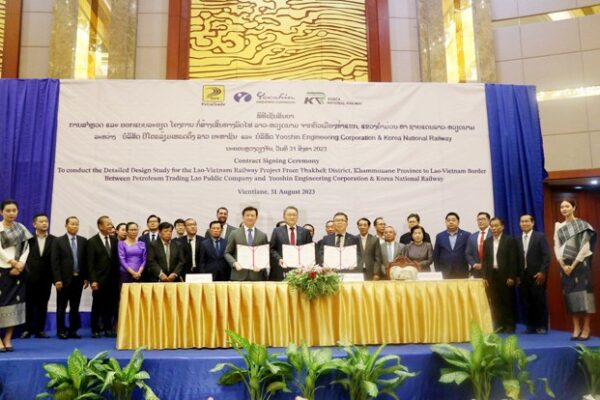
Lao officials, villagers in the dark about impacts of new railway
Construction of the Laos-Vietnam high-speed railway is expected to begin in early 2024, but its potential impacts on villagers who live along the planned route through Laos’ Khammouane province have not yet been made public, provincial officials and residents said. The US$6.3 billion, 555-kilometer (345-mile) railway is being built under a public-private partnership and will connect Laos’ capital Vientiane to the Vietnamese seaport of Vung Ang in Ha Tinh province. The cross-border railway is a joint venture between Petroleum Trading Lao Public Company and Vietnam’s Deo Ca Group Joint Stock Company. The project is part of a larger plan by the Lao government to build several new railroads to increase trade in the mostly poor, landlocked country. The 150 kilometers (93 miles) of railway built during the first phase of construction in Laos will run from the Lao-Thai border in Khammouane province’s Thakhek district to the Lao-Vietnamese border. During phase two, 313 kilometers (194 miles) will be built from the Laos-Thai border to Vientiane. The project survey and design for this phase has yet to be completed. The project’s environmental impact assessment and an environmental and social impact assessment have been completed but not disclosed to the public, the sources said. An official from the province’s Department of Natural Resources and the Environment told Radio Free Asia that he didn’t know how many Lao residents would be affected by the construction because the companies involved have not shared the information with him. “Everything has to be based on the information from the companies,” he said Monday. “I have not seen any reports about how many families and villages will be affected. The district has not been informed.” Major infrastructure projects in Laos, such as hydropower dams and other railways, have caused the forced relocation of villagers and the loss of land they use along with their planted crops. Those affected have complained of being shortchanged on monetary compensation offered by the companies involved in the projects. An official from Khammouane province’s People’s Council told RFA on Monday that he has not seen the assessments either, so he doesn’t know how many villagers will lose their land or be relocated. Representatives of companies involved in the Laos-Vietnam railway sign the contract for the project in Vientiane, Laos, Aug. 31, 2023. Credit: Vientiane Times Villagers express concern Some residents who believe they may be affected by the project said they have not received any information, and there is no relevant office they can go to for information about the project’s impacts. A villager in Thakhek district said he has not received any information about the railway construction project and that provincial administrators have not informed villagers because they are afraid that some will oppose the project and demand fair compensation. With other development projects in the province, some affected residents complained about receiving low compensation, he said. The villagers were not happy about receiving compensation that was less than the market value of land they lost, he said. “The Lao government rarely reports on this via state media,” the villager added. Another villager in Mahaxay district said she learned about the railway project via social media, but officials have yet to inform villagers about the potential impacts. The signing ceremony for the construction took place in Vientiane in late August between Petroleum Trading Lao Public Company, South Korea’s Yooshin Engineering Corporation, and Korea National Railway, which were tasked with conducting a detailed design study of the railway before construction began. Chanthone Sitthixay, chairman of Petroleum Trading Lao Public Company, told Lao Star Channel on Aug. 31 that phase one of the railways in Laos was expected to take a little over two years to complete. In Vietnam, the railway will span 103 kilometers (64 miles) from the Laos-Vietnam border to Vung Ang seaport. The Laos-Vietnam railway is expected to be completed and enter into operation by 2028. Translated by Phouvong for RFA Lao. Edited by Roseanne Gerin and Matt Reed.
US officials: China’s economic woes may slow military rise
China’s military may be more aggressive than ever before, but economic woes could force some tough spending decisions that slow its continued rise, two U.S. defense officials said Monday. Speaking at the Atlantic Council about the Pentagon’s latest China Military Power Report, an annual evaluation of Beijing’s military power mandated by Congress, the officials said China’s economic troubles coincided with higher costs of military modernization. “They are getting into areas that are more expensive and more technologically complex,” said Michael Chase, the deputy assistant secretary of defense for China, Taiwan and Mongolia. Chase said Beijing relied more on the People’s Liberation Army “as an instrument of advancing his foreign policy objectives” than ever before, and that an economic slowdown would not likely change that. But U.S. officials, he said, were watching “whether a slowing economy imposes some trade offs between different projects that are important components of PLA modernization.” He listed the building of aircraft carriers, nuclear weapons and foreign bases as big-ticket items. “We’re probably beginning to see some of that evidence, and I think we’ll see more of it over time,” he said. “They’re becoming increasingly technologically sophisticated and, therefore, increasingly pricey.” Nuclear threat Released last week, the China Military Power Report says Beijing last year continued to build its nuclear weapons arsenal and may even be considering building missiles capable of reaching the United States. It also reiterated last year’s report that said China is the U.S. military’s “top pacing challenge” and the “the only competitor with the intent and increasingly the capability to reshape the international order.” Ely Ratner, the assistant secretary of defense for Indo-Pacific security, told the Atlantic Council on Monday that despite that assessment, he agreed that China’s economic issues had thrown a spanner in the works – both for the military and for its regular diplomacy. “We may be seeing some of those trade-offs already,” Ratner said. “We have seen for instance, over the last couple of years, Belt and Road investments by [China] dropping dramatically around the world.” The Belt and Road Initiative was “one of the top priorities for the leadership in Beijing” when it was launched 10 years ago, he said, but “because of their economic slowdown, you see them less able and less willing to be supporting those kinds of investments overseas.” “So even things that are high priorities are getting cut in the face of this economic slowdown, and the PLA will be no different over time.”
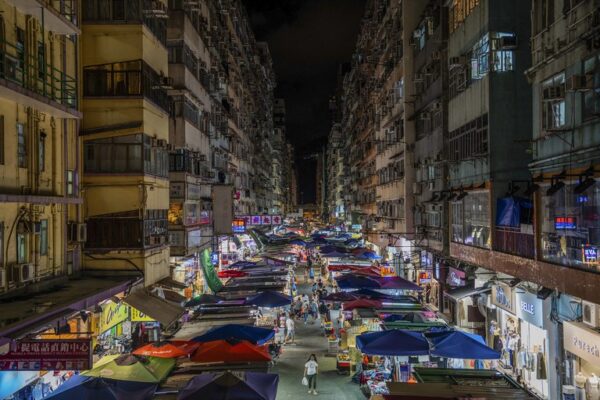
Will Hong Kong’s star shine again?
A typical Friday evening in Mong Kok district comes to a hush before midnight. It is the new normal for a district once fused with the buzz and raw energy that was the essence of Hong Kong. Yet, it is the old vibe that Hong Kong officials are aspiring to recover. In mid-September, the government launched “Night Vibes Hong Kong,” involving night markets, food stalls, movie screenings and live music events over weekends. Over the past 12 months, it has rolled out campaigns including a six-month program to bring tourists back and also gone on global roadshows to win back investors. The effectiveness of the efforts remains elusive, despite Chief Executive John Lee’s vow to a year ago in his maiden policy speech to go all out to draw back talent and businesses to a city battered by a stringent zero-COVID policy and Beijing’s hardened grip. Tell the world the good stories of Hong Kong was the mantra, he quipped. As Lee prepares to make his second policy address this week, analysts say the good stories are few, and the issues that have eroded Hong Kong’s unique competitiveness continue to chip away. The city’s international financial center and economic hub positions are crumbling under the weight of Beijing’s tightened grip of the special administrative region where the “one country, two systems” principle is taking a new form under Chinese President Xi Jinping. “Hong Kong’s major indicators – freedom, rule of law, international financial center status, international standards of practices, property market, stock market, government’s financial reserves – are all on the decline, and it is a Hong Kong government problem,” points out Lew Mon-hung, a businessman and former Chinese People’s Political Consultative Conference committee member. ‘Promoting Marxism’ To be exact, it’s a problem stemming from Beijing, Lew says, because Hong Kong’s progress and fate are intricately tied to China’s continuous reforms as they have been the past four decades. That path, however, has been stymied by the shift in political climate in the mainland, and the Chinese National People’s Congress’s passing of the National Security Law in June 2020 – bypassing Hong Kong’s legislature – to quell months of anti-government protests. “In China now, they are promoting Marxism – having gotten into the philosophy of struggle, wolf warrior diplomacy,” which Lew says comes at the expense of economic and thought regressions. People walk through an outdoor market in Hong Kong’s Mong Kok area on Aug. 20, 2022. Credit: Bertha Wang/AFP These weighed on the “one country, two systems,” China’s constitutional principle to govern Hong Kong under a mini-constitution called the Basic Law, where the city is allowed freedom of assembly and speech, an independent judiciary and some democratic rights – except in the areas of diplomacy and defense. “Beijing reckons that Hong Kong only needs to play an economic role after its return to Chinese rule,” says Hong Kong current affairs commentator Johnny Lau Yui-siu. “But Hong Kong people’s view of the world is different from mainland China’s political awareness and consciousness. And Beijing wants Hong Kong to align.” Hong Kongers, he says, are outward-looking, used to international practices, free flow of information and speech, unlike their Chinese counterparts who are restricted by the boundaries that the Chinese Communist Party had set. As China stalls in its convergence towards international standards, Hong Kong became the by-product of that stagnation, Lau says. The numbers add up The numbers tell the same story. China’s exports fell 14.3% and 8.8% in July and August respectively, while Hong Kong’s fell 9.1% and 3.7%. The benchmark stock index has lost about 12% since the beginning of 2023 and Hong Kong’s property prices are forecast to fall 5% for the year, according to a commercial real estate services firm Cushman & Wakefield. The uncertainties that keep foreign investors guessing about where the political winds blow in China also reverberate in Hong Kong. China’s crackdown on industries such as the technology sector, as well as its more recent position to let an indebted property industry go into a free fall, have done little to assure investors. A pedestrian passes the Hong Kong Stock Exchange electronic screen in Hong Kong on July 21, 2023. Credit: Louise Delmotte/AP The latest annual survey by the American Chamber of Commerce in Shanghai published in September showed that the percentage of U.S. firms optimistic about their outlook on China over the next five years slid to 52%, the lowest level since the annual report was introduced in 1999. In Hong Kong, a member sentiment survey by the AmCham in Hong Kong released in March found that American businesses’ three biggest challenges are U.S.-China tensions, a weakening global economy and the overseas perception of Hong Kong, a factor that was previously absent. “If the HKSAR Govt can reassure international investors that the rule of law will prevail, and the NSL will not put their staff in jeopardy, it will go a long way. But it is at the moment delivering neither,” says Steve Tsang, director of the SOAS China Institute at SOAS University of London. Rebuilding reputation The chamber has urged Hong Kong chief Lee to provide “straightforward interpretations and applications” of the law in his upcoming policy speech. In its written submission in September to the public consultation for the policy address, the chamber wants Lee to reassure businesses that the law will be applied narrowly and be consistent with the principles of an independent judiciary. The ramifications of the national security law, which criminalizes any act of secession, subversion, terrorism and collusion with foreign or external forces, have never ceased since it was implemented. How the Hong Kong government has used the law to change the political and civic institutions in the city has alarmed a wide spectrum of the society. Opposition parties and media outlets were shuttered, while pro-democratic figures have either been arrested or have fled the city. An earlier post-COVID reopening by longtime rival Singapore didn’t help. Toeing Beijing’s stringent zero-COVID policy was a death knell for…
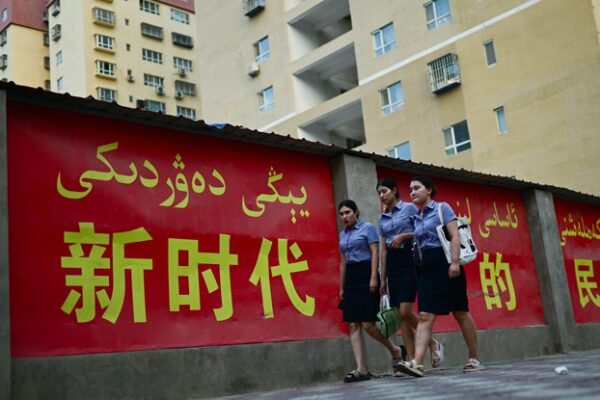
51 nations blast China over violating Uyghurs’ rights
In a joint statement, 51 countries, including the United States, expressed deep concern to the United Nations on Wednesday over Chinese human rights violations of Uyghurs in its far-western Xinjiang region. The move comes after China was elected to the U.N. Human Rights Council for the 2024-2026 term – despite its poor track record in protecting rights. “Members of Uyghur and other predominantly Muslim minorities in Xinjiang continue to suffer serious violations of their human rights by the authorities of the People’s Republic of China,” said the statement, which was delivered by James Kariuki, Britain’s U.N. ambassador. It urged China to respond to an August 2022 report issued by the U.N. Office of the High Commissioner for Human Rights, or OHCHR, which concluded China’s mass detentions of Uyghurs and other predominantly Muslim minorities on a large scale in Xinjiang “may constitute international crimes, in particular crimes against humanity.” The report found that “serious human rights violations” have been committed in the Xinjiang Uyghur Autonomous Region amid the Chinese government’s claims of countering terrorism and extremism. The assessment cited evidence of invasive surveillance on the basis of religion and ethnicity, restrictions on cultural and religious practices, torture and ill-treatment of detainees, forced abortion and sterilization of Muslim women, enforced disappearances, family separations, and forced labor, the statement noted. “Over a year has passed since that assessment was released and yet China has not engaged in any constructive discussion of these findings,” said the statement issued at the U.N.’s Third Committee, which meets annually in early October to deal with human rights, humanitarian affairs and social matters. In its recommendations, the OHCHR had called on the Chinese government to release detainees from camps and other detention facilities, issue details about the location of Uyghurs in Xinjiang who have been out of touch with relatives abroad, allow travel so families can be reunited, and investigate allegations of human rights abuses. ‘Strong remedial action’ At the most recent session of the U.N’s Human Rights Council in September, Volker Türk, the current high commissioner for human rights, called on China to follow the recommendations of the assessment and take “strong remedial action.” Maya Wang, associate director of the Asia division at Human Rights Watch, said maintaining pressure on China is part of a continued effort to hold the country accountable for its actions in Xinjiang. “Suffice it to say that moving a government as abusive and powerful as China’s takes a lot of effort and time, and that pressing the U.N. to keep prioritizing human rights in its interactions with China is part of this long and hard effort,” she told Radio Free Asia. Women walk past a propaganda slogan promoting ethnic unity in ‘the new era,’ in both Chinese and Uyghur languages, in Yarkand, northwestern China’s Xinjiang region, July 18, 2023. Credit: Pedro Paro/AFP The New York-based right group called on U.N. Secretary-General António Guterres on Monday to press Chinese President Xi Jinping to end crimes against humanity in Xinjiang and other serious rights abuses in China, during a visit to Beijing to attend the third Belt and Road Forum on Oct. 17-18. “Since becoming secretary-general in 2017, Guterres has shown reluctance to publicly criticize the Chinese government for its severe and worsening repression,” HRW said in a statement. Growing number Dolkun Isa, president of the World Uyghur Congress, welcomed the joint U.N. statement, noting that a few African and South American countries have signed this year’s statement condemning China’s atrocities against Uyghurs. “In 2019, there were only 20 countries that signed on to the joint statement,” he said. “Despite China’s efforts to spread disinformation to cover up it genocide against Uyghurs by increasing tourism, inviting friendly diplomats and journalists to the region, the fact that there are more countries signed on to this joint statement this time proves the complete failure of China’s disinformation campaign,” he said. Luke de Pulford, executive director of Inter-parliamentary Alliance on China, said the latest statement should not be confused with action. “We shouldn’t be fooled,” he told RFA. “It’s good that the U.K. should be applauded for taking some symbolic action, but these statements do not achieve accountability. It shouldn’t be confused and conflated with accountability.” Xinjiang regional expert Adrian Zenz agreed that “writing a letter was good, but it cost you nothing,” he tweeted on X, formerly known as Twitter. “You are not paying any actual price for your values,” he wrote. “Actions speak louder than words. Actions could include: Effective forced labor ban. Legal atrocity determination. Sanctioning higher level officials.” Translated by RFA Uyghur. Edited by Roseanne Gerin and Malcolm Foster.
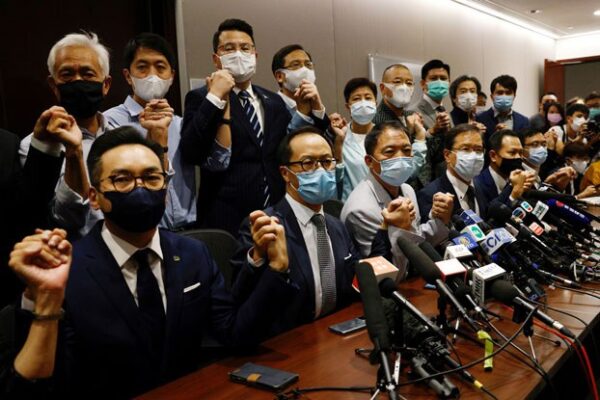
Police arrest former opposition councilor amid call to boycott poll
Hong Kong police have arrested a former pro-democracy member of the city’s District Council and prison welfare activist — amid calls for a boycott of forthcoming district elections, which are open to “patriots only.” Derek Chu, a 46-year-old former directly elected councilor who resigned in 2021 before being forced to take an oath of loyalty to the Hong Kong and Chinese governments, was arrested in Shatin on Tuesday on suspicion of breaching the city’s mandatory pension law, police told the paper. His arrest comes as the government moves ahead with an “election” process that will slash the number of directly elected seats on the District Council by 80%, while ensuring that almost nobody in the city’s once-vibrant opposition camp will stand for election again, the result of ongoing arrests of pro-democracy figures and rule changes requiring political vetting. “At about 12 noon, Derek Chu was taken to an office at Manulife Plaza in Kwun Tong by the police for evidence collection,” the report said. “He was later taken to a food store in W Plaza in Mong Kok and Fuk Keung Industrial Building in Tai Kok Tsui for investigation.” Those locations are linked to Chu’s “Migratory Bird” platform to support prisoners, which raised money via the As One online shopping platform – part of the “yellow economic circle of pro-democracy businesses” – to support his prison work. He is currently being held by the Sham Shui Po Crime Division pending further investigation, after his home was also searched and documents confiscated, the paper reported. Pan-democratic legislators announce their resignation from Hong Kong’s Legislative Council in Hong Kong, Nov. 11, 2020. Credit: Tyrone Siu/Reuters Chu was a member of the last directly elected District Council, which saw a landslide victory for pro-democracy candidates amid record turnout that was widely seen as a ringing public endorsement of the 2019 protest movement. He resigned his seat along with many like-minded colleagues amid an ongoing crackdown on dissent under a national security law imposed on the city by Beijing from July 2020. ‘Patriots’ only The government later changed the Legislative Council electoral rules to ensure only “patriots” loyal to Beijing could stand as candidates or hold any kind of public office, prompting record-low turnout of 30.2% in Legislative Council elections in December 2021 compared with more than 70% in the last District Council poll. Officials then rewrote the District Council poll rules in May, citing a “disastrous” result in the 2019 election, sparking calls from overseas activists for a boycott of the forthcoming poll on Dec. 10. “Abandon illusions, boycott this fake election,” read an Oct. 16 statement on Facebook signed by dozens of former pro-democracy councilors. “We, the last district councilors to be elected by the citizens of Hong Kong, solemnly declare that we will not recognize these so-called elections run by the Communist regime of Hong Kong, and call on all citizens of Hong Kong to boycott the election and the councilors it produces,” the statement said. It said candidates wishing to take part have to run a complex gamut of vetting from support for nomination to a slew of official recommendation letters to political background checks, “all of which runs counter to the democratic spirit,” warning that anyone who makes it to the list of candidates is “purely a permitted cheerleader for the regime.” It said the government also looks set to use the “election” as an opportunity to engage in “the political brainwashing of minors.” “This so-called election will actually take place under military totalitarian rule, and can have no fairness or legitimacy,” the councilors wrote. Australia-based former pro-democracy lawmaker Ted Hui, who signed the statement, said the forthcoming poll is a “huge step backwards for democracy” in Hong Kong. “Most of the seats will be controlled by the government,” Hui said. “We believe that it would be best for citizens to totally refuse to take part, to boycott [the election].” ‘Huge step backwards’ Some parties in the democratic camp have said they will field candidates, though it remains to be seen if their bid for candidacy will be accepted. The Democratic Party has said it hopes to field six candidates, and the Association of Democracy and People’s Livelihood wants to field two. Candidates celebrate after winning in the Legislative Council election in Hong Kong, December Dec. 20, 2021. The rules for the election were changed to ensure only ‘patriots’ loyal to Beijing could stand as candidates or hold any kind of public office. Credit: Lam Yik/Reuters But Hui said this could send a dangerous signal about complicity with the authorities, who have told opposition parties to give up any hope of “Western-style democracy” in the city. “One or two [pro-democracy candidates] might pass the test and get nominated, but this will do great harm, because it shows the people of Hong Kong that they agree with this huge step backwards for democracy,” he said. Former district councilor Sam Yip, who also signed the statement, said it was naive of pro-democracy parties to imagine it was worth contesting such elections. “It helps to whitewash these elections, which are illegal, unfair and inconsistent with the whole concept of democracy,” Yip said. “Their actions are actually ruining democracy.” ‘A screening process’ Secretary for Home and Youth Affairs Alice Mak, asked if the government is expecting turnout to fall in this year’s poll, said it wasn’t the most important thing. “We should not just look at the turnout in District Council elections, [which can be] affected by many factors, such as the weather, including whether it rains that day, whether there is a typhoon in the summer, and whether the weather will be too cold,” Mak said. “The most important thing is how to find patriots who sincerely serve the community and citizens through the electoral system,” she said. Former Hong Kong Island Eastern District councilor Derek Ngai, who also resigned to avoid taking his oath, said democrats faced with the oath of loyalty requirement feared being required to pay back two…

‘Some of them will be sent to … camps,’ some ‘may be executed’
North Koreans who have escaped to China need help to avoid being sent back against their will, and pressure on Beijing from South Korea alone is not enough to stop it, a former North Korean diplomat told Radio Free Asia. “It is important to send a strong message of international unity to prevent the Chinese authorities from forcibly repatriating [them],” said Thae Yong-ho, who is now a member of the South Korean parliament. “It is difficult to stop it with only the demands of the South Korean government.” The remarks come a week after Beijing secretly repatriated more than 500 North Koreans on Oct. 9, the day after the conclusion of the Asian Games in Hangzhou, China. Thae, who in 2016 defected with his family to the South while serving as Pyongyang’s deputy ambassador to the United Kingdom, is visiting Washington D.C. to inspect the South Korean Embassy in his role as a member of the national assembly representing Seoul’s wealthy Gangnam district. He is scheduled to meet with U.S. State Department officials and members of Congress to discuss the forced repatriation issue. A bus carrying escapees from North Korea crosses the bridge to North Korea’s Sinuiju from China’s Dandong on Aug. 29, 2023. Credit: Kim Ji Eun/RFA Thae said that Seoul had been repeatedly trying to raise the issue with Beijing. “Foreign Minister Park Jin and Unification Minister Kim Young-ho have both publicly requested that China stop repatriating North Koreans, ” said Thae. “Also, during the Hangzhou Asian Games, Prime Minister Han Duck-soo visited China and met with President Xi Jinping, demanding that North Koreans not be repatriated.” Even with the public requests and off-the-record pleas, China continues to justify forced repatriation by claiming that North Korean escapees in China are “illegal displaced persons” rather than refugees. More than words The distinction is not simply an issue of semantics. If escapees are not refugees, then China argues it is not bound to protect them under the U.N. Refugee Convention and as illegal immigrants, the principle of non-refoulement does not apply to them. Beijing maintains that it must repatriate North Koreans who fled the country because it is bound by two agreements it has with Pyongyang, the 1960 PRC-DPRK Escaped Criminals Reciprocal Extradition Treaty and the 1986 Mutual Cooperation Protocol for the Work of Maintaining National Security and Social Order and the Border Areas. If they are made to return to North Korea, many escapees will face a grim fate, Thae said. “Some of them will be sent to concentration camps for [at least] several months of detention and forced labor, and if they are found to have tried to escape North Korea and go to South Korea, they may be executed,” Thae said. Thae recalled his own fears of forced repatriation at the time when he decided to defect. “At the time, I was also very worried that some unexpected variable might arise in the process of defecting from North Korea,” he said. “People still detained in detention facilities in China are probably very anxious and worried that they will be forcibly repatriated to North Korea. During his U.S. trip, Thae has plans to meet with American officials to request that they join their voices in opposition against forced repatriation of North Koreans in China. “We plan to deliver a letter to President Biden appealing to the U.S. government to speak up [on this issue],” said Thae. “We plan to deliver it to the lawmakers [Monday]. There should be a campaign nationwide and globally calling for an end to forced repatriations. Thae attended an event hosted by human rights groups in front of the White House on Monday afternoon to raise awareness about the issue. New US Envoy On Friday, Washington swore in Julie Turner as its special envoy for North Korea Human Rights, ending a six-year vacancy for the position. She arrived in Seoul on Monday for a three-day visit. After meeting with Foreign Minister Park, the two sides promised to work together to improve North Korean human rights. Addressing a forum of rights activists and North Korean escapees in South Korea, Turner acknowledged that the United States often brings up the issue of forced repatriations in discussions with Beijing. “So I again hope that the PRC will not [repatriate North Koreans] and we will continue to remind them of their international obligations, but I can’t say that I believe that they will not,” she said. Julie Turner, the United States’ new special envoy for North Korea Human Rights, arrived in Seoul on Monday for a three-day visit. Credit: U.S. Department of State Thae said that he was regretful that he and Turner missed each other as his trip to the U.S. coincided with her trip to Korea. “We plan to meet at an early date and discuss specific ways to help the U.S. speak out more for North Korean human rights issues in the international community and what strategies and strategies can be used to solve the North Korean human rights issue and stop forced repatriation,” he said. Translated by Eugene Whong. Edited by Eugene Whong and Malcolm Foster.

